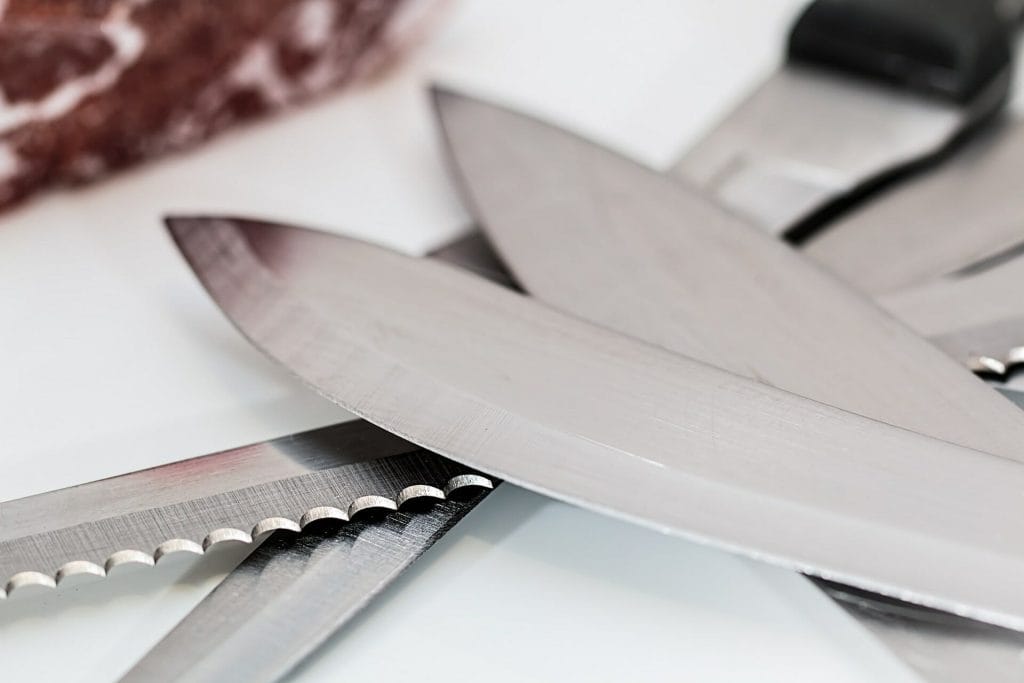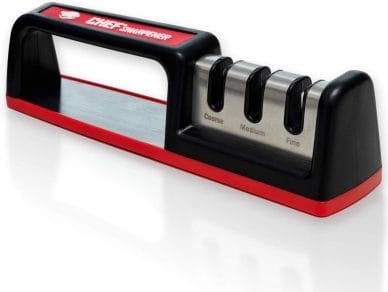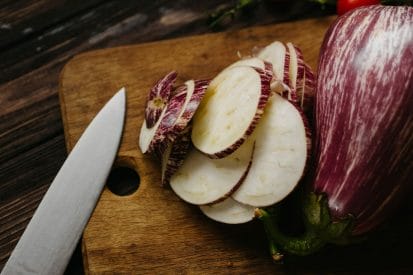A lot of people are asking “do knife sharpeners work?” The answer is YES, but only if you know how to use them properly. Check out this blog post to learn how to use a knife sharpener.
If your knives dull and in serious need of restoration? Come find out with us if using a knife sharpener can save the day, or if it’s just a waste of time. Let’s dive into the facts and figure out what the best tool is to get your kitchen knives as sharp as one like a samurai sword!
Introduction
Sharp knives are an indispensable tool in the kitchen, and learning how to use a knife sharpener is key to any chef’s culinary success. In order to produce quality results, it’s important to understand how knife sharpeners work and what types of sharpeners are available on the market. There are two main categories of knife sharpeners — those that manually shape blades using abrasive stones and those that mechanically hone blades with grinding wheels. While the stones must be used in combination with skill and practice, electric knife sharpeners offer a quick and easy solution for honing blades quickly without the need for expertise. This article on “do knife sharpeners work” will provide an overview of different types of sharpeners, as well as tips for choosing a model that meets your needs.
What is a Knife Sharpener?
A knife sharpener is a device used to maintain the sharpness of a knife’s blade. It can range from simple manual sharpeners, such as those made of stones or rods, to complex electric-powered models. Manual sharpeners usually consist of two opposite abrasive surfaces which are used to grind away and shape metal from the blade edge. Electric sharpeners often have several slots with various degrees of abrasive setting and will automatically pull the blade through without having to hold and drag it along by hand.
No matter what type of sharpener you use, proper technique is essential for a good result. It’s important to use slow and steady strokes that consistently move toward the tip of the blade in order to ensure an even grind across its entire surface. Furthermore, it’s important to not press too hard against the abrasive surfaces as this may cause overheating which can damage your knives’ blades. Regular honing with a honing rod after every few sharpenings will also help maintain a consistent sharpness on your knives over time.
Types of Knife Sharpeners
There are a variety of knife sharpeners available, each with its own advantages and purposes. For example, electric sharpeners offer convenience and speed but deliver a very fine sharpening effect. Handheld sharpeners are easier to control but may require more skill to use. However, the type of sharpener used is not as important as the quality of the material it’s made out of – because even the best knife won’t stay sharp if you use a dull or low-quality sharpener. Some popular types of knife sharpeners include:
Edge Pro Knife Sharpeners: These are designed to make your knives sharper by gently grinding away any imperfections in the metal. The Edge Pro is one of the most popular models in this category; it makes it easy for beginner and intermediate users to get professional results without spending too much time or money.
Electric Knife Sharpeners: Electric knife sharpeners are designed for convenience and speed; they typically have built-in guides that help you align your blade properly, and can quickly assess how dull your blade is before beginning work on it. This makes them perfect for busy kitchens where getting through tough tasks quickly is essential. However, due to their simplicity, electric knife sharpeners tend to provide less precise results than manual ones do – so they’re better suited for fast general-use knives than they are for expensive high-end ones you want to be kept in top condition at all times.
Sharpening Stones: Sharpening stones offer some advantages over both electric and manual methods; they provide finer results than electric sharpeners and more control than manual ones. However, due to their complexity stones typically require more practice before delivering consistent results — so this type of sharpener isn’t recommended for most beginner users without assistance from an experienced pro.
No matter which type of knife sharpener you choose, with proper technique it can be used effectively for getting blades back into cutting shape again – or even improving an already good edge! Hope you are enjoy reading our article on the do knife sharpeners work.
Benefits of Using a Knife Sharpener
Using a knife sharpener is the most effective way to keep your kitchen knives in good condition. Knife sharpeners can help restore a knife’s blade edge quickly and easily. The biggest benefit of sharpening with a knife sharpener is that it does not require any specific skill or technique—it can be done by people with any level of expertise. With the right type of sharpener, you will be able to quickly get your knives back to the best cutting performance possible.
In addition to improving the performance of your knives, there are other benefits of using a knife sharpener:
Safer: A sharper blade helps reduce the chances of accidents in the kitchen as it requires less pressure and has less chance of slipping while cutting.
More efficient: A sharper blade helps reduce preparation time as it allows for easier and faster-cutting action when slicing and dicing fruits, vegetables, and other ingredients.
More productive: Sharp blades allow cooks to take on larger quantity orders without having to pause frequently to sharpen their knives again.
More cost-effective: Sharpeners are more cost-effective than buying new knives, typically lasting longer than the typical kitchen tool.
How to Use a Knife Sharpener
As with many kitchen tasks, using a knife sharpener is a skill that is best learned with practice. The basic steps for sharpening your knives are generally the same no matter what sharpener you use. Be sure to read the instructions that come with your particular sharpener, as there may be minor variations for optimal results.
When using a manual knife sharpener:
1. Secure the sharpener firmly on a flat surface.
2. Place the blade of the knife in one of the slots in the sharpener and draw it gently but firmly across it in one continuous stroke at an angle of 10-20 degrees from vertical. Stroke away from your body and always use extreme caution when handling knives and sharpeners.
3. Repeat Step 2 on each side of the blade until the desired level of sharpness is achieved (usually 3-4 strokes).
4. Carefully remove and inspect your knife for any burrs or rough spots remaining on either side and carefully finish them off if needed with very light finish strokes on each side of the blade until all roughness has been removed and both sides of the blade are smooth again.
Check 5 Best Knife Sharpeners Under $30 online
Check knife sharpeners at Amazon
When using an electric or motorized knife sharpener:
1. Securely clamp down both your device and work area surface before beginning to sharpen your blades to prevent any unexpected movement during operation that can potentially cause injury or harm to you or damage to your knives or devices themselves if they’re not clamped down correctly first!
2. Ensure all safety switches are turned on before powering up and follow the manufacturer’s instructions for particular safety precautions associated with that model depending on its specific design features (some may have ball-bearing protection mechanisms, others may not!)
3. Carefully insert each blade into its respective slot making sure it follows the correct alignment designed by the manufacturer (usually including some form of diagram schematics)
4. Pull blades through several times, usually at least 3-5 times per side best suited for most stainless steel blades, which should effectively sharpen them but do take extra caution when processing harder metals such as carbon steel!
Always remember never to tug too hard as this can cause permanent deformations so always ask yourself if you’re applying pressure more than necessary before continuing! Taking too much off at once might also ruin certain features like serrations present on some blades so proceed carefully following instructions provided by the manufacturer & don’t ever exceed their specified run times!
Finally, most models include adjustable dial settings which allow user control over precise cutting angles achieved during operation – make sure these settings correspond properly with those mastered during practice sessions beforehand & ensure the machine is enabled only when actually set up properly first – virtually all models have safety collars preventing accidental activation otherwise which must be handled afterward if triggered against best usage practices!
Common Knife Sharpening Mistakes
A variety of tools are available for sharpening a dull blade, ranging from simple manual sharpeners to electric and mechanical models. Knowing the basics of how to sharpen a knife can help you get the job done without damaging your blade.
Common mistakes include holding the knife incorrectly, using improper sharpening techniques, using too much pressure, or over-sharpening. Here are a few tips on avoiding these mistakes while correctly utilizing basic knife sharpening tools:
• Hold the blade securely in your hand with two fingers positioned behind the blade and your thumb placed on the back side of your chosen sharpening surface. This will help maintain control as you move the blade in circles for both manual and electrical/mechanical sharpening tools.
• Use light pressure in short strokes at an angle of roughly 15 to 20 degrees away from yourself as you go from the tip of the knife toward its handle. Make sure to keep a consistent motion and avoid pressing down too hard on the stone or other sharpening surfaces. You should end each stroke with slight movements up or down so that both sides can be equally sharpened appropriately.
• Stop when you have achieved an even-edged finish along each side of your knife – putting too many strokes into it can ruin your edge altogether. Once finished, wipe off any debris left over with a damp cloth before testing if it’s adequately sharpened with a few cuts of paper or cardboard. Keeping steel honing rods nearby will extend their life considerably between major sharpenings while routinely cleaning blades after use are essential!
Also, check out 5 Best Knife Sharpeners under $100 in 2023
Tips for Maintaining a Sharp Knife
Sharp knives are essential for accurate, safe food preparation. Regular maintenance is important for avoiding injury and maintaining precision: clean them regularly, store them properly, and sharpen them occasionally. Choosing the right sharpener like one of those recommended by Cook’s Illustrated can help you keep your knives in top shape.
While manufactured sharpeners provide a more precise edge than some methods, there are several different ways to maintain a sharpened edge on a knife. Honing is one of the most common techniques. It consists of drawing a metal or ceramic rod (also called a honing rod or steel) along each side of the blade at either a 20- or 15-degree angle several times in one direction. This technique straightens out microscopic bends in the blade and can revive smaller dull spots without removing too much metal from the blade’s surface.
Another option is manual sharpening using stones or whetstones (diamond stones are popular choices). Start by using the coarsest stone your knife requires and press it against both sides of the knife in alternating strokes until you reach your desired level of sharpness; then switch to finer stones until you have finished honing. Be sure to lubricate with water or oil when manually sharpening to avoid frictional heat that could damage the delicate metal on your blade.
Finally, as an alternative option for light touchups, electric sharpeners can be effective if used correctly. These use ceramic discs, diamond pads, or coarse abrasive stones to restore an edge on blunt blades with just a few seconds of work; however, these sharpeners should only be used rarely as they may cause more harm than good if used excessively over time on quality kitchen blades.
Conclusion
The answer is yes, knife sharpeners can work, but it depends on the type of sharpener and the condition of the blade. Some blades are too dull or damaged to be able to be effectively sharpened. Sharpening a blade requires skill, knowledge, and patience, and trying to sharpen a severely dull or damaged blade can take much longer or even permanently damage it.
Generally speaking, for knives that can actually be sharpened, most knife sharpeners will be able to get them back up to par. The key is to use the right one for your particular type of knife and ensure you follow all instructions and watch YouTube tutorials if necessary. There are several different types of knife sharpeners available and some may work better than others depending on the style of knife you have so do some research before making a purchase.



